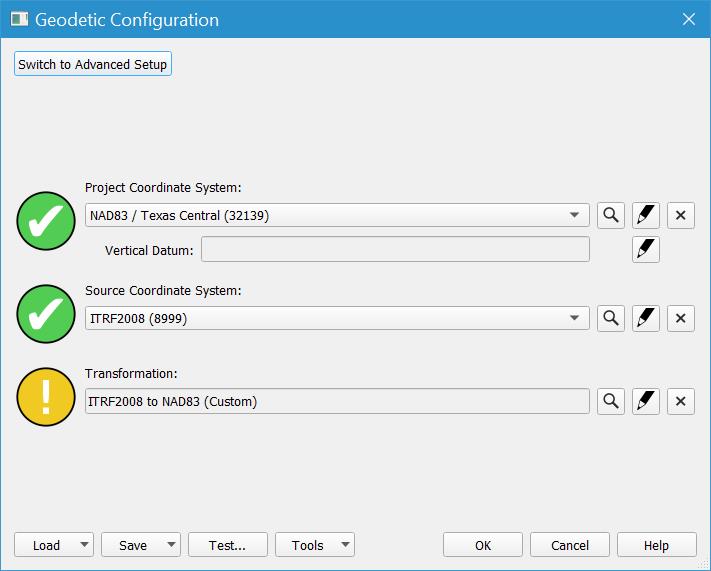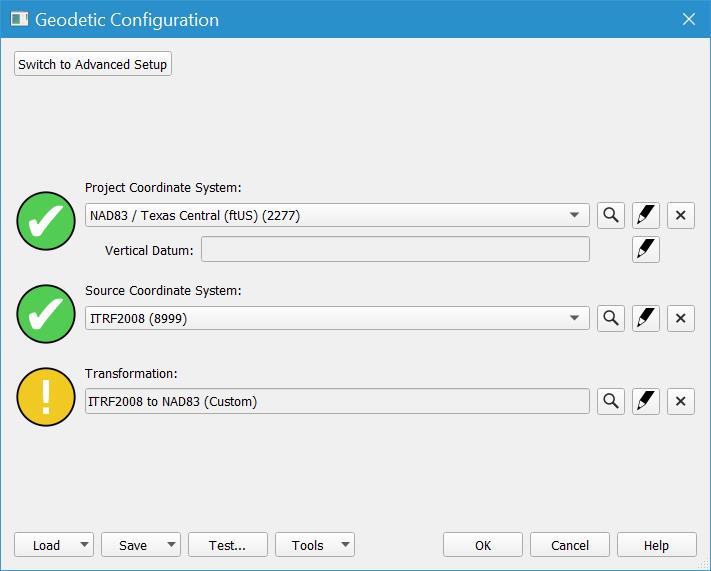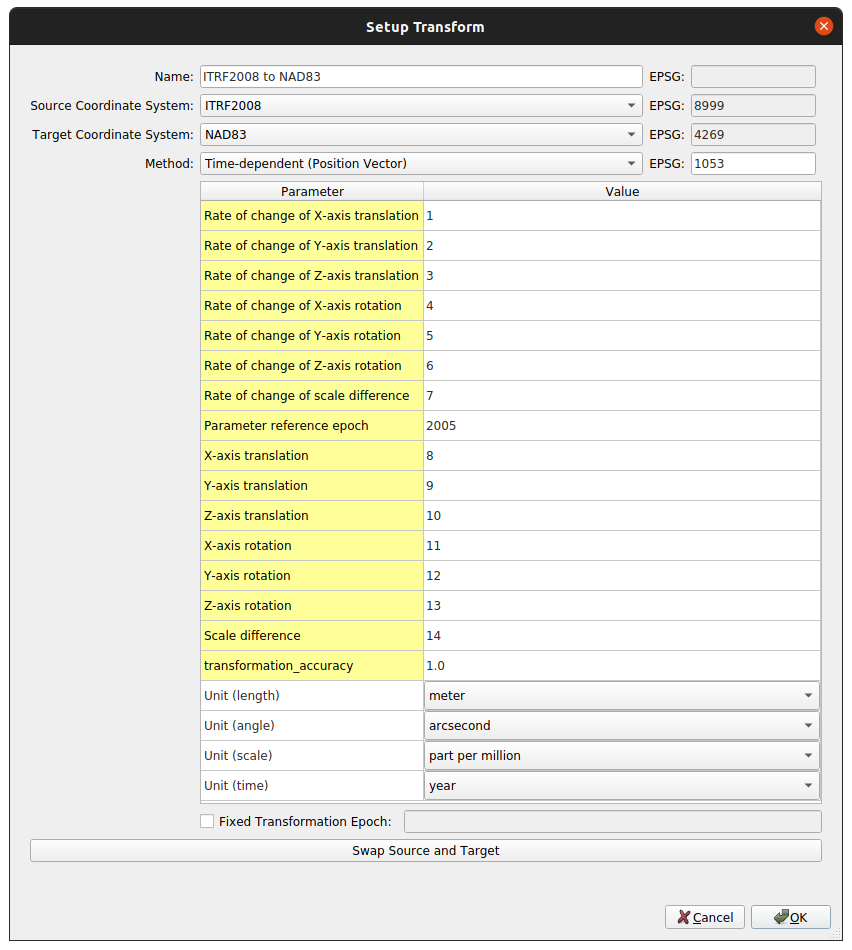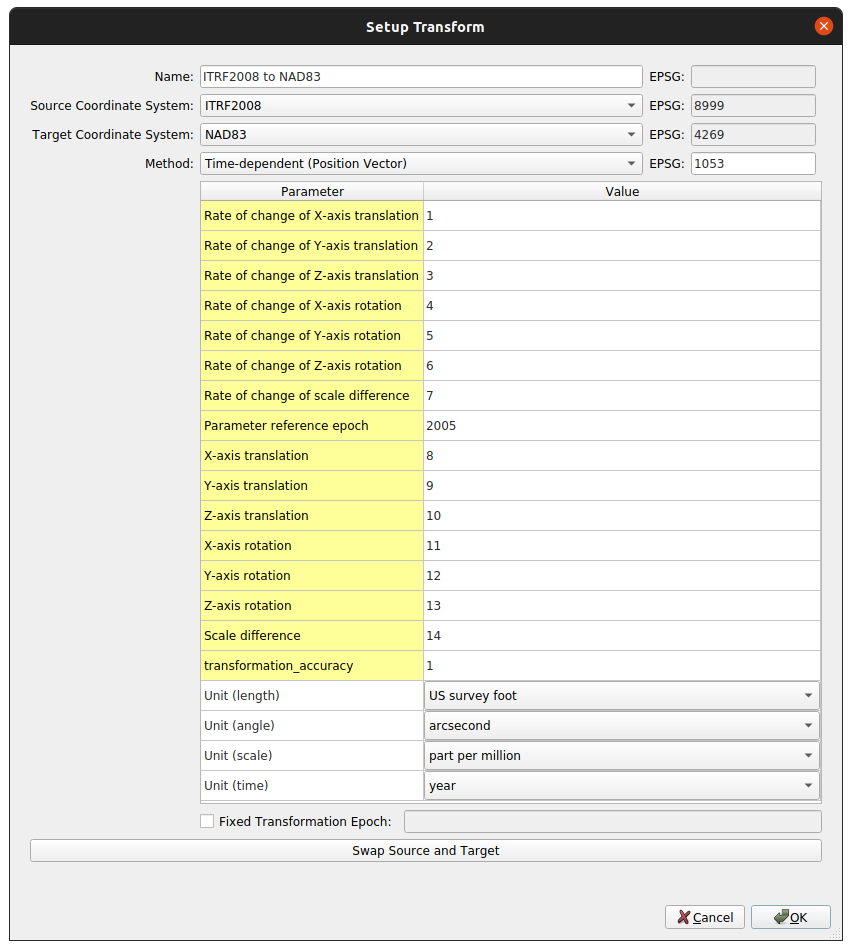How-to Deal with NAD83 Datum and Time-dependent Transformation Parameters
A question frequently asked by GNSS users in the United States is: How do I transform coordinates between the frames defined by NAD83 and ITRFyy?
For users in Europe, the question is: How do I transform between ETRS89 and ITRFyy?
In truth, modern-day reference frame transformations have become increasingly complex to better accommodate time-dependent processes such as plate tectonics and other geophysical phenomena.
In fact, many modern frame transformations extend the classical 7-parameter Helmert transformation to complex 14-parameter formulations, which augment the original 7 parameters with their time derivatives.
This document contains:
Info: Transformation Parameter Values
Typically transformation parameter values are published.
Most can be found in the QPS Knowledge Base here: ITRF_Transformation_Parameters_.xlsx
NAD, ITRS and WGS84
The North American Datum 1983 (NAD83) is a geocentric datum that was established in 1986 for the United States, Canada, Mexico, Central America and the Caribbean Islands.
Hawaii and Greenland were also connected to this datum. Being fixed to the North American Plate, it plays the same role for North America as ETRS89 does for Europe.
It uses the GRS80 as its reference ellipsoid.
The orientation of the ECEF coordinate axes of the original NAD83 (1986) reference frame is identical to that of the original World Geodetic System 1984 (WGS84) reference frame (also known as WGS84 (1987), WGS84 (original), WGS84 (TRANSIT)).
For surveying purposes, the WGS84 (original) is identical to the original NAD83 (1986). Since then the two reference frames have diverged due to plate motion.
WGS84 (original) was connected to ITRF90 by a 7-parameter Helmert transformation. From 1997 on, WGS84 has been maintained within 10 cm of the realizations of the International Terrestrial Reference System (ITRS), known as ITRFyy.
For these realizations there are no official transformation parameters. This means that one can consider that ITRF coordinates are also expressed in WGS84 at 10 cm level.
However, the most recent G1674 realization adopted ITRF2008 coordinates for more than half of the reference stations and velocities of nearby sites for the others.
Thus, ITRF2008 and WGS84 (G1674) are likely to agree at the centimeter level, yielding conventional 0-transformation parameters.
For more information, check WGS84.TXT.
On September 6, 2011, the National Geodetic Survey (NGS) adopted the latest realization of its geodetic reference frame, i.e. NAD83 (2011) Epoch 2010.0.
The frame actually consists of three independent frames consistent with the rotations of three tectonic plates and are officially known as NAD83 (2011), NAD83 (MA11) and NAD83 (PA11) respectively for the North American Plate, the Mariana Plate and the Pacific Plate.
Info: Geodetic Information
Please refer to Geodetic Information for additional details about NAD83, WGS84 and ITRF. The text includes a table listing all the NAD83 realizations.
Some additional papers containing useful explanations and datum transformation parameters are Soler and Snay, 2004 and Pearson and Snay, 2012.
For a utility that allows users to transform positions across time and between reference frames, see HTDP - Horizontal Time-Dependent Positioning.
NAD83 transformations
The following explanations use the particular example where the GNSS receiver is outputting ITRF2008 coordinates which are to be transformed to NAD83 2011 (epoch 2010.0).
In the figure below IGS08 is the same as ITRF2008 (1674).

The same principles would still apply when transforming between other alternative ITRF and NAD83 realizations.
Station Velocities
Info: Station Velocities
Generally speaking, geographic points located in the eastern and central United States have NAD83 velocities that are close to zero, and therefore their NAD83 positional coordinates should not change much between different epochs.
This is not the case for geographic points in the United States that are located within a few hundred kilometers of the Pacific Coast; here NAD83 horizontal velocities with magnitudes in excess of 5 mm / year are prevalent.
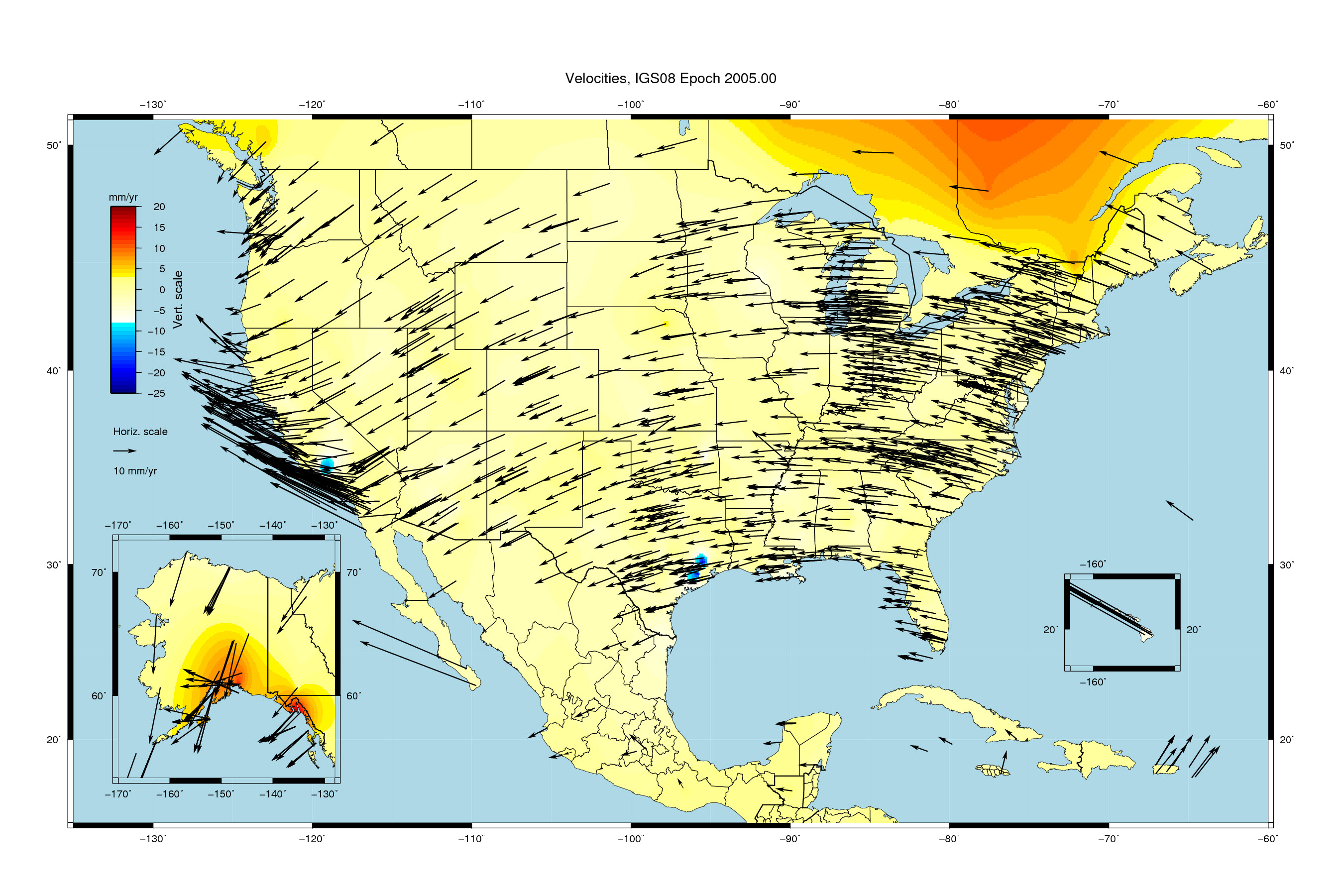
Time Dependent Datum Transformation Parameters
Datum transformation parameters encountered on the Geodetic Configuration Overview are needed to transform time-dependent position coordinates between two datum ellipsoids.
It is possible to enter these parameters after defining the Project CRS and the Input CRS. Usually the 'Input' datum is ITRF (or another GRS80-based datum), and the 'Projected' CRS is the local survey datum.
In this example the datums are ITRF2008 and NAD83.
A US State Plane Coordinate System is also selected.
Note: NAD83 SPCS Units
Note that, while the 'official' unit for NAD83 State Plane is 'meters', some States have chosen to use US Survey Feet, others use International Feet and a few use Meters. BE CAREFUL WHICH YOU USE.
Perhaps the best option is to first accept Meters as the default unit, enter all the transformation parameters given in ITRF_Transformation_Parameters_.xlsx in meters, and then select US Survey Feet in the drop-down box.
This automatically converts all metric parameter values to feet.
Geodetic Configuration - Guided Setup
| Meters | US Survey Feet |
|---|---|
|
|
Info
For the Project Coordinate System, it is possible to select the 'meter' or the 'US Feet' option.
Open the drop-down box and search for the Project Coordinate System that is desired.
Geodetic Configuration - Transformation
In case a Time-dependent Transformation is selected, the Transformation page at the Geodetic Configuration requires entry of the Fixed Parameters as well as the Parameter reference epoch t0 of the datum transformation.
t0 is entered as decimal years.
| Meters | US Survey Feet |
|---|---|
|
|
This window is divided into various parts:
| Setup Transform | |
|---|---|
| Name | Name of the transformation, automatically filled by the dialog. It is possible to change this name to a custom name. |
| Source Coordinate System | Input Datum. In this example the datum transformation is from ITRF2008 (Epoch 2005.0) to local datum NAD83 (2011). NOTE: The current ITRF realization is WGS84 (G1674) / ITRF2008 (Epoch 2005.0). Typically the GNSS positioning data output is referenced to this realization. |
| Target Coordinate System | Local Survey datum. In this example the datum transformation is from ITRF2008 (Source CRS) to local datum NAD83 (Target CRS). |
| Method | Options are:
There are two possible rotation modes: Position Vector Rotation and Coordinate Frame Rotation. In this example, Time-dependent (Position Vector) |
| Rate-of-change | Enter the rate-of-change parameters for t0 (in units per year). The rate that the Shift parameters dX, dY and dZ change per year, i.e. how quickly the origins of the two datum ellipsoids move apart or together. NOTE: Be aware that time-dependent parameter values are often given in millimeters (mm) and milliarcseconds (mas). |
| Parameter reference epoch | The reference epoch t0 must be defined when a Time-dependent Transformation has been selected. In this example, 2005.0 |
| Parameters | Shift parameters dX, dY and dZ define the translation (shift) between the origins (coordinate axes) of the two datum ellipsoids. Other combinations of ITRF and NAD83 realizations follow the same principles. NOTE: Be aware that published time-dependent parameter values are often given in millimeters (mm) and milliarcseconds (mas). |
| Unit (length) | Select between meter, millimeter, US Survey Foot, Foot or Fathom In this example, meter or US Feet. |
| Unit (angle) | Select between degrees, arcseconds (1/3600 degrees), milliarcseconds, radians, microradians (10-6 radians), and grads. In this example, arcseconds. |
| Unit (scale) | Select between part per million, part per billion and unity. In this example, Part per Million. |
| Unit (time) | By default set to year. |
| Fixed Transformation Epoch | The transformation epoch t is the time which is to be used for the actual datum transformation computations, in decimal year format, for a time-dependent datum transformation. Note: A dynamic epoch is used in most cases, since for a transformation from a fixed global datum to a moving continental datum, you would want to apply the full shift due to plate tectonics up to the date of survey. A fixed transformation epoch would only be used in case of test points (for a specific date), if a GNSS receiver outputs positions on the continental datum for a specific date, or if you specifically require the use a specific date. In case this epoch is dynamic, Qinsy (in online mode) will use the middle of the current day (12:00 UTC) to compute new dynamic datum transformation parameters. In this example nothing is defined, so a dynamic epoch will be used. |
Database Setup - Convert Reference Epoch
A decimal year value can be converted from a calendar date using the 'Convert Reference Epoch' option in the Database Setup program.
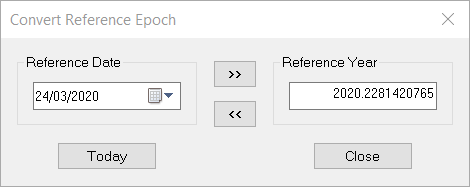
Reference Frames - Differential Corrections
GNSS positions are defined in terms of earth centered, earth fixed Cartesian coordinates, X, Y and Z.
Typically, they are converted into the latitude, longitude and height system, sometimes referred to as a geographic coordinate system.
Coordinate systems are based on mathematical models of the earth called datums that can be defined globally or for specific regions.
Over time the models are updated as continents shift and the earth’s surface changes, and hence many revisions of a single datum can exist.
Differential corrections are generated against a known coordinate, referred to as the reference position.
It is important to understand that for the exact same physical location, many reference positions can exist, depending on how the coordinate system was defined.
For example, the National Geodetic Society in the US, under the Continually Operating Reference Stations (CORS) program, publishes reference positions for each reference station in terms of both the ITRF2008 datum and the NAD83 (2011) datum.
When using differential corrections, an important issue to bear in mind is that GNSS positions generated from differential corrections will be in terms of the datum used for the reference position.
If GNSS positions are to be used in the context of GIS data referenced in a different frame, the positions must be transformed to that new reference frame.
If this is not done, an offset (often referred to as a datum shift or bias) is observed between the GNSS position and the background GIS data. This can be a difference of meters.
Mixing Reference Frames
Differential correction sources use a variety of reference frames. Autonomous GNSS positions use the WGS-84 (World Geodetic System) datum as the reference frame.
WAAS corrections use ITRF2000 (International Terrestrial Reference Frame), US Coast Guard beacons use the NAD83 (2011) (North American Datum), and OmniSTAR uses NAD83 in North America and WGS84 in all other world areas.
Post processed GNSS positions are in terms of the base provider’s reference position.
This variety of reference frames means mixing autonomous, real-time, and post-processed positions can lead to inconsistency in your data.
Merging data from different reference frames requires vigilance, otherwise you may be unknowingly comparing data from one coordinate system with data from another.
The best safeguard against introducing datum shift errors into your data is to post-process all data—including real-time corrected data—against a base provider with a reference position in a known datum.
All post processed positions will be in this known datum. After post-processing, carefully apply the appropriate datum transformation between your GNSS data and your GIS.
Info: More Information
A series of four papers about Modern Terrestrial Reference Systems,
by Snay and Soler, originally published in the Professional Surveyor:
Part 1: Modern Terrestrial Reference Systems

